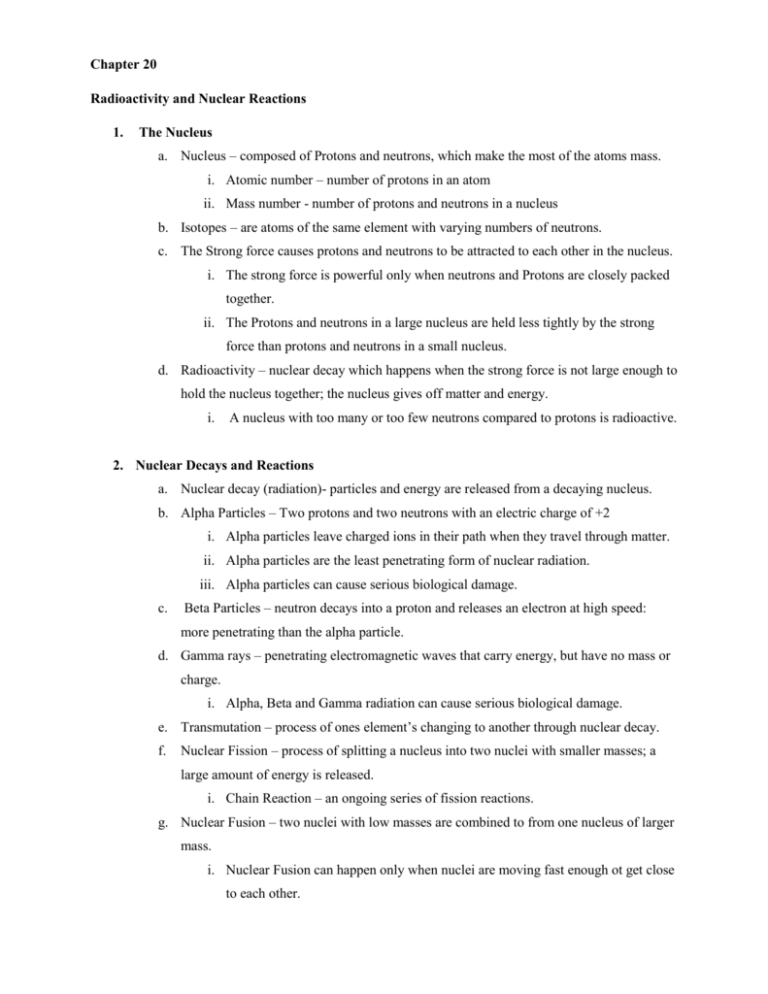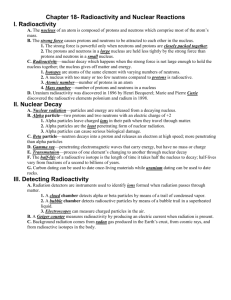Ch. 20 Notes
advertisement

Chapter 20 Radioactivity and Nuclear Reactions 1. The Nucleus a. Nucleus – composed of Protons and neutrons, which make the most of the atoms mass. i. Atomic number – number of protons in an atom ii. Mass number - number of protons and neutrons in a nucleus b. Isotopes – are atoms of the same element with varying numbers of neutrons. c. The Strong force causes protons and neutrons to be attracted to each other in the nucleus. i. The strong force is powerful only when neutrons and Protons are closely packed together. ii. The Protons and neutrons in a large nucleus are held less tightly by the strong force than protons and neutrons in a small nucleus. d. Radioactivity – nuclear decay which happens when the strong force is not large enough to hold the nucleus together; the nucleus gives off matter and energy. i. A nucleus with too many or too few neutrons compared to protons is radioactive. 2. Nuclear Decays and Reactions a. Nuclear decay (radiation)- particles and energy are released from a decaying nucleus. b. Alpha Particles – Two protons and two neutrons with an electric charge of +2 i. Alpha particles leave charged ions in their path when they travel through matter. ii. Alpha particles are the least penetrating form of nuclear radiation. iii. Alpha particles can cause serious biological damage. c. Beta Particles – neutron decays into a proton and releases an electron at high speed: more penetrating than the alpha particle. d. Gamma rays – penetrating electromagnetic waves that carry energy, but have no mass or charge. i. Alpha, Beta and Gamma radiation can cause serious biological damage. e. Transmutation – process of ones element’s changing to another through nuclear decay. f. Nuclear Fission – process of splitting a nucleus into two nuclei with smaller masses; a large amount of energy is released. i. Chain Reaction – an ongoing series of fission reactions. g. Nuclear Fusion – two nuclei with low masses are combined to from one nucleus of larger mass. i. Nuclear Fusion can happen only when nuclei are moving fast enough ot get close to each other. ii. Temperatures in stars are high enough for fusion to occur. 3. Radiation Technologies and Applications a. Geiger counter – tool used to measure radioactivity by producing an electric current when radiation is present. b. Background Radiation – comes from radon gas produced in the Earth’s crust, from cosmic rays and from radioactive isotopes in the body. c. Tracers – are radioactive isotopes used by doctors to locate molecules in an organism. i. Common tracers include technetium-99m and Iodine-131 they emit gamma rays which medical equipment can detect. d. Half-life – is the amount of time it takes for half the nuclei in a sample of an isotope to decay. i. Half-lives can be as short as a micro-seconds or billions of years long. e. Radiometric dating (carbon dating) – can be used to date once-living materials while uranium dating can be sued to date rocks. Chapter 20 Vocabulary Alpha particle - Particle consisting of two protons and two neutrons that is emitted from a decaying atomic nucleus Beta particle - High-energy electron that is emitted when a neutron decays into a proton Chain reaction - Series of fission reactions caused by the release of additional neutrons in every step Geiger counter - Radiation detector that produces a click or a flash of light when a charged particle is detected Half-life - Amount of time it takes for half the nuclei in a sample of a radioactive isotope to decay Radioactivity - Process that occurs when a nucleus decays and emits matter and energy Strong force - Attractive force that acts between protons and neutrons in an atomic nucleus Tracer - Radioactive isotope, such as iodine-131, that can be detected by the radiation it emits after it is absorbed by a living organism Transmutation - Process of changing one element to another through radioactive decay











